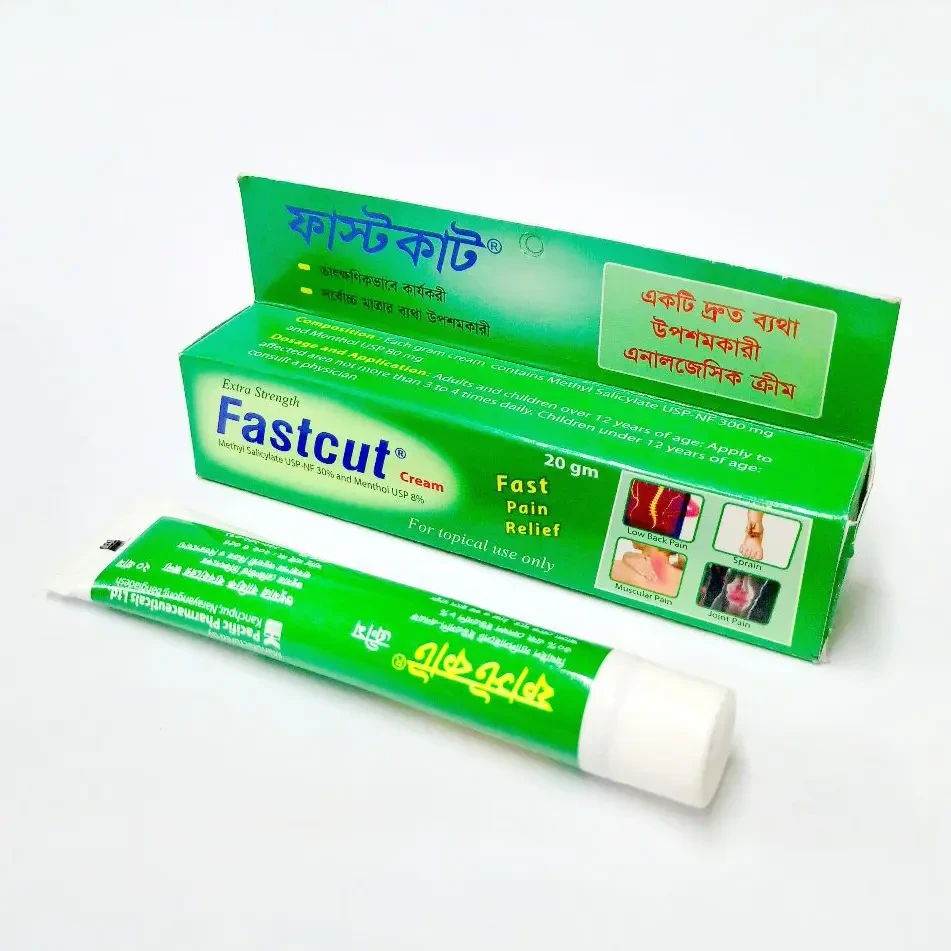Fastcut Uses, Dosage, Side Effects and more
This is a specially formulated Methyl salicylate and Menthol cream. It penetrates into skin to provide fast relief from pain and stiffness of minor arthritis and muscle aches. This cream is fast acting, strong medicine that penetrates deep down to provide long lasting and effective relief. Methyl salicylate has been shown that first pass metabolism exists in the skin and rapidly hydrolyzing salicylate ester to release the active salicylate in both epidermis and dermis. It alleviates pain and inflammation by inhibiting the synthesis of prostaglandins that occur in inflamed tissues. Menthol increases the penetration of drugs when applied on the skin to give a faster onset of action. It dilates the blood vessels causing a sensation of coldness followed by an analgesic effect.

| Attribute | Details |
|---|---|
| Trade Name | Fastcut |
| Generic | Methyl Salicylate + Menthol |
| Weight | 30%+8% |
| Type | Cream |
| Therapeutic Class | Local Antipruritic, Topical Analgesics, Topical anti-inflammatory preparations |
| Manufacturer | Pacific Pharmaceuticals Ltd |
| Available Country | Bangladesh |
| Last Updated: | January 7, 2025 at 1:49 am |
Uses
This cream is used for the fast relief of minor aches and pains of muscles and joints associated with Arthritis, Bursitis, Rheumatism, Tendonitis, Simple backache, Strains, Sprains, Leg cramps
Fastcut is also used to associated treatment for these conditions: Acute Muscle Pain, Arthritis, Back Pain Lower Back, Backache, Contusions, Joint Pain, Ligament pain, Muscle Inflammation, Muscle Injuries, Muscle Strain, Muscle swelling, Pain, Pain of the Bone and Bones, Pain, Nerve, Partial-Onset Seizures, Postherpetic Neuralgia, Soreness, Muscle, Sprains, Tendon pain, Minor aches, Muscle, joint pains
How Fastcut works
Counter-irritation is thought to be effective at alleviating musculoskeletal pain as the irritation of the sensory nerve endings is thought to alter or offset pain in the underlying muscle or joints that are served by the same nerves . This is thought to mask the underlying musculoskeletal pain and discomfort. When applied topically, methyl salicylate is thought to penetrate the skin and underlying tissues where it reversibly inhibits cyclooxygenase enzyme and locally and peripherally prevents the production of inflammatory mediators such as prostaglandin and thromboxane A2.
Dosage
Adult and children 2 years of age and older: Apply a thin layer to the affected area and gently massage until cream disappears. Apply to affected area not more than 3 to 4 times daily. This is for external use only.
How Long Does It Take to Work?
How Long Does It Take to Work? see here Fastcut
Side Effects
Redness or irritation may occur, especially in persons with sensitive skin. Adverse reactions possibly involved are mild to moderate local irritation, erythema, rash, desquamation, pruritis and relative local reaction at the application site.
Toxicity
Oral LD50 values (mg/kg) for mouse, rat and rabbit are 1110, 887 and 1300, respectively. Oral LD50 values for child and adult human (mg/kg) are 228 and 506, respectively. Although systemic toxicity from topical administration is rare, methyl salicylate can be absorbed in intract skin to cause stimulation of the central nervous system respiratory center, disturbance of lipid and carbohydrate metabolism, and disturbance of intracellular respiration. Severe toxicity can result in acute lung injury, lethargy, coma, seizures, cerebral edema, and death. In case of salicylate poisoning, the treatment consists of general supportive care, gastrointestinal decontamination with activated charcoal in cases of salicylate ingestion, and monitoring of serum salicylate concentrations. Bicarbonate infusions or hemodialysis can be used to achieve enhanced salicylate elimination .
Precaution
Avoid contact with the eyes and mucous membranes. Do not bandage tightly, wrap or cover until washing the area. It should not be applied to wounds or damaged skin. It should not be used immediately after bath. Wash hand thoroughly after applying.
Volume of Distribution
After absorption, methyl salicylate is distributed throughout most body tissues and most transcellular fluids, primarily by pH dependent passive processes. Salicylate is actively transported by a low-capacity, saturable system out of the CSF across the choroid plexus. The drug readily crosses the placental barrier.
Elimination Route
Approximately 12-20% of topically applied methyl salicylate may be systemically absorbed through intact skin within 10 hours of application, and absorption varies with different conditions such as surface area and pH. Dermal bioavailability is in the range of 11.8 – 30.7%. For the assessment of potential oral exposure to salicylates, bioavailability is assumed to be 100% .
Half Life
The plasma half-life for salicylate is 2 to 3 hr in low doses and about 12 hr at usual anti-inflammatory doses. The half-life of salicylate may be as long as 15 to 30 hr at high therapeutic doses or when there is intoxication.
Elimination Route
Excreted by kidneys as free salicylic acid (10%), salicyluric acid (75%), salicylic phenolic (10%) and acyl glucuronide (5%), and gentisic acid (less than 1%).
Pregnancy & Breastfeeding use
Its safety in human pregnancy has not been established. This preparation should therefore be given to pregnant women only in compelling circumstances.
Contraindication
Hypersensitivity to salicylate or any of its ingredients
Acute Overdose
Large amount of topical application may cause absorption through the skin and may cause salicylism. Symptoms of salicylism include tinnitus, hearing loss, nausea, vomiting etc.
Storage Condition
It should be stored in a cool and dry place away from light. Keep out of the reach of children.



